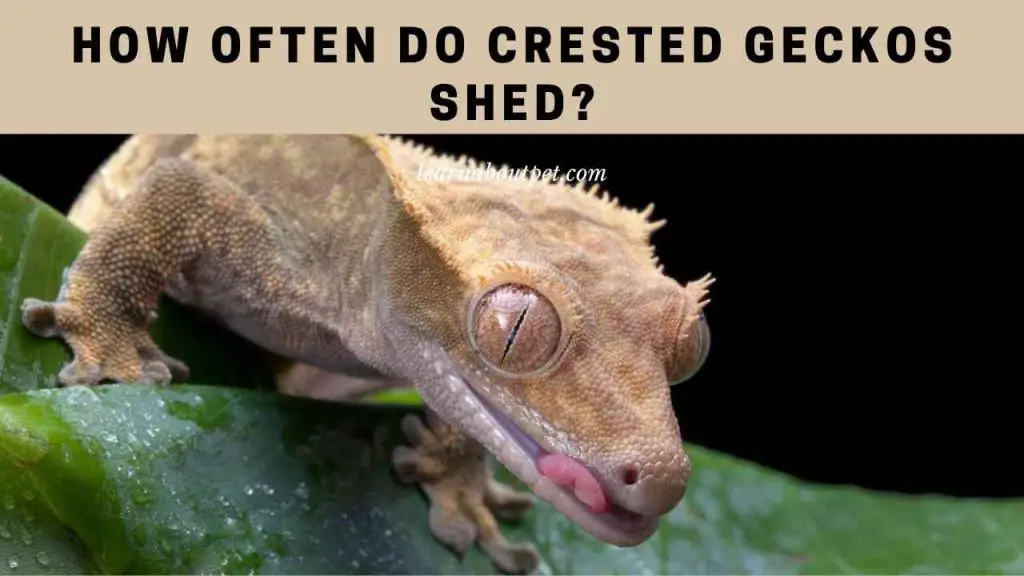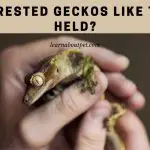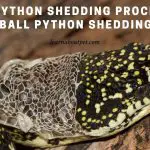One of the most frequently asked questions about crested geckos is the one on how often they shed. In this article, we answer that question comprehensively – and also explore the shedding phenomenon in the crested geckos at some length.
How often do crested geckos shed? The frequency with which a crested gecko sheds mostly depends on its growth rate. Baby crested geckos typically shed weekly. Juvenile crested geckos usually shed once every two weeks, whereas adult crested geckos normally shed once per month.
The shedding entails sloughing off a layer of old skin. This happens when a crested gecko has generated a layer of new skin cells. So the new layer of skin takes the place of the old layer, which is shed off.

Do Crested Geckos Shed Their Skin?
There are people who have kept crested geckos for many years, yet they have never once caught them in the act of shedding skin.
That is what causes this question, on whether these geckos shed their skin at all.
And it is indeed a question that is worth looking into, before proceeding with the discussion on how often do crested geckos shed?
So, indeed, do geckos shed their skin? Or, to be more specific, do crested gecko shed their skin?
The answer is ‘yes’. But the shedding process moves quite fast. It is over in 15-20 minutes. And it normally happens at night. Moreover, the geckos typically proceed to eat their skin, after shedding it.
This is why you may never catch your crestie shedding skin. But they do shed, via a process we refer to as ecdysis.
Once they have a new layer of skin, they shed the old layer of skin – in order to fully expose the new layer.
Why Do Crested Geckos Shed?
Normally, the how often do crested geckos shed question is preceded by this one: on why the crested geckos shed in the first place.
The main reason why these geckos shed is in order to expose a new layer of skin. Once a crestie grows a new layer of skin, it needs to slough off the old layer, in order to expose the new skin layer.
This is what happens during shedding.
It is also worth remembering that as the gecko grows, its skin doesn’t grow with it.
Therefore the old skin (which the gecko had when it was smaller in size) has to be shed off at some point, in order to expose the new layer of skin (which covers its now bigger body size).
At yet another level, the shedding helps to get rid of any parasites that may have made a home in the old layer of skin.
So, in a nutshell, this is why the geckos shed skin.
How Do Crested Geckos Shed?
Typically, the person who poses the how often do crested geckos shed question will also have an interest in knowing how the shedding actually happens.
Now shedding in these geckos entails sloughing off an old layer of skin, in order to expose a new layer of skin.
Simply put, the gecko pulls off its old skin (and this normally requires quite a bit of strength). Pulling off the old skin exposes the new layer of skin.
One of the most fascinating aspects of crested gecko shedding behavior is in that the gecko proceeds to eat the old skin after shedding it!
This it does to replenish the nutrients it will have used up in making the new layer of skin. Therefore if you had the do crested geckos eat their shed skin question, now you know the answer.
They do eat their shed skin. Normally, they eat it promptly after shedding. The shedding may take 15-20 minutes. Then right after it, the gecko proceeds to eat the shed skin.
This is why it can be hard for people who are unfamiliar with these lizards to tell if they shed at all. After all, the shedding happens quite fast, and at night. Then the gecko eats the shed skin, leaving no telltale signs of shedding having taken place.
One may then ask, do crested geckos shed their skin all at once or in bits? And the answer is that if a gecko is healthy, well hydrated and in a place with good humidity, it should be able to shed its skin all at once.
With all this background information, we can now proceed to answer the how often do crested geckos shed question.
How Often Do Crested Geckos Shed?
The frequency with which crested geckos shed depends on their growth rate, which in turn depends on the stage of life they are in.
For instance, in baby crested geckos, the shedding normally happens weekly. This is because the baby geckos grow so fast. So they are continually outgrowing the old layers of skin, which then have to be shed.
Therefore if you had the how often do baby crested geckos shed question, now you know the answer. It is typically weekly.
As they grow into juveniles, they start shedding less often. So they now start shedding like once every two weeks.
When they become adults, the shedding becomes even less frequent. Now they start shedding like once per month.
Therefore if you had been wondering, how often should a crested gecko shed, now you know the answer. It should be roughly weekly for baby cresties, fortnightly for juvenile crested geckos and monthly for adult crested geckos.
This shedding pattern is also common with most other types of geckos. For instance, if you try to find out, how often do gargoyle geckos shed, you will find that the answer is more or less the same as that for crested geckos.
How Long Does It Take For A Crested Gecko To Shed?
While exploring the how often do crested geckos shed subject, it is also worthwhile for us to look into the question of how long it actually takes for them to shed.
So, indeed, how long does a crested gecko shed last? How long do crested geckos shed?
The answer is that the actual shedding (sloughing off the old layer of skin, to expose a new one) typically takes only 15 to 20 minutes.
But preparations for the shedding start many days in advance. The gecko becomes less active. It starts eating less. Meanwhile, the new layer of skin, which the gecko is to remain on once it sheds the old layer, continues maturing…
All in all, the actual shedding takes 15 to 20 minutes.

When Do Crested Geckos Shed?
Another key pillar, in exploring the how often do crested geckos shed subject is this one: where we seek to know when the crested geckos shed.
Now these geckos are, for most part, nocturnal. So they are usually most active at night. And that is also when they shed their skins.
You are unlikely to find a crestie shedding its skin during the daytime. They normally shed at night.
And they start shedding right from when they are born, right up to the time they die.
Only the frequency of the shedding changes: with baby cresties shedding weekly, juveniles fortnightly and adult crested geckos monthly or so.
How Do I Know When My Crested Gecko Is About To Shed?
The person who poses the how often do crested geckos shed question may also have an interest in knowing how to tell when a crested gecko is about to shed.
There are several crested gecko shedding signs that are hard to miss.
Geckos that are about to shed will, firstly, normally lose their appetite. Most actually stop eating for the period when they are just about to shed.
Therefore if you have been wondering, do crested geckos stop eating when they shed, now you know the answer. They do tend to stop eating when they are about to shed.
That also answers the do crested geckos eat when shedding question. The answer is that their appetite really goes down.
The second sign of a gecko that is about to shed is where they generally become less active. Actually, they tend to become lethargic. They are trying to preserve their energy for the shedding process, which can be quite draining.
The third sign of a gecko that is about to shed is where their skins become duller.
The geckos may also start to squint. This is because they are about to shed the skin around their eyes. (So if you have been wondering, do crested geckos shed their eyes skin, now you know that the answer is yes).
So there may be a bit of squinting for that reason.
These signs are obviously more frequent in geckos that shed more often.
For instance, we already established that for a baby crested gecko shedding takes place more often than for an adult crested gecko.
Consequently, the baby crested gecko will tend to experience these signs of shedding – loss of appetite, lethargy, duller skin and squinting – more often.
How To Help A Crested Gecko Shed
After answering the how often do crested geckos shed question, it may be a good idea for us to go further, and explore how to help a crested gecko shed.
This is an important aspect of crested gecko husbandry.
The most important thing you can do, to help a crested gecko shed is ensure that it has adequate humidity and it is properly hydrated.
You may therefore need to mist the enclosure where you keep the gecko more frequently.
Then ensure that it is getting enough water to drink.
This way, the old layer of skin will slough off easily, when shedding time actually comes.
At shedding time, if you provide a wet towel in a moist box, it may help make the shedding a whole lot easier for the gecko.
One may ask: should I handle my crested gecko while shedding? And the answer is that you need to avoid handling the gecko while it is shedding. This is because handling may distress the gecko.
Moreover, in the course of handling, you may end up irritating the newly exposed layer of skin, which is still very sensitive.
So it is best to wait for the shedding process to be over, before starting to handle the gecko again.
You really need to avoid anything that may interfere with the shedding process. Remember, if the shedding goes awry, the gecko may remain with blood supply problems.
Those may in turn lead to crested gecko feet problems: like where the feet, on account of poor blood supply, become dark and eventually fall off.
The same can also happen to the gecko’s tail tip.
So it is best to do everything you can to ensure that your lizard has a smooth shedding process.
Why Isn’t My Crested Gecko Shedding?
Earlier, while answering the how often do crested geckos shed question, we saw that baby cresties normally shed weekly, juveniles fortnightly and adults monthly.
Further, we saw that the shedding frequency mostly depends on the growth rate.
Therefore if you have a situation where your crested gecko isn’t shedding at all, it means that it has completely stopped growing. Therefore because there is absolutely no growth/development of new skin cells, it doesn’t shed.
This should be cause for concern. You need to investigate the reason behind the gecko stopping to grow.
Is it because of a disease? Or is it because of parasites? Could it be due to improper diet? Or could it be due to tank conditions: things like humidity and temperature?
All in all, as we saw in the course of answering the how often do crested geckos shed question, the shedding should take place weekly, fortnight or at least monthly, depending on the life stage the gecko is at.
If you have a crested gecko that is not shedding at all, it should be cause for concern: sometimes warranting a visit to an exotic pets vet.
Final Verdict – How Often Do Crested Geckos Shed
The frequency with which crested geckos shed depends on their growth rate. Geckos that are growing faster will tend to shed more frequently than those that are growing at a slower rate.

All in all, baby crested geckos –whose rate of growth is highest, typically shed every week.
Juvenile crested geckos usually shed every two weeks.
And adult crested geckos normally shed monthly.
You need to ensure that your crested gecko is properly hydrated, and that there is proper humidity in its enclosure at/around shedding time. This will increase chances of the skin shedding process being smooth.
As a pet lover, make sure to learn about pet more and give your pet gecko a good and comfortable life!

Welcome to Learn About Pet. My name is Rajkumar Ravichandran and I love all pets, travel, and amazing food. I write about my passion and personal experience caring for multiple pets in this blog! ❤️
Post Disclaimer
DISCLAIMER: THIS BLOG OR WEBSITE, "Learn About Pet", DOES NOT PROVIDE YOU WITH MEDICAL ADVICE AND IS NOT A SUBSTITUTE FOR MEDICAL ADVICE. ALWAYS GET IN TOUCH WITH YOUR PERSONAL VETERINARIAN AND USE INFORMATION HERE AS GENERAL ADVICE.
The information, including but not limited to, text, graphics, images and other material contained on this website are for informational purposes only. No material on this site is intended to be a substitute for professional veterinary advice, food recommendation, diagnosis, or treatment. Always seek the advice of your veterinarian or other qualified health care provider with any questions you may have regarding a medical condition or for pet food related questions.







